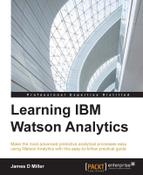A high-level look at the practice of content analysis reveals five basic steps, or phases:
- Defining a purpose (for the analysis effort)
- Obtaining relevant data
- Performing the analysis
- Determining action(s) to take
- Validation
Note that you'll utilize Watson Analytics when performing the analysis and this step involves a series of sub-steps:
- Applying preprocessing logic to the data, if required.
- Performing analysis using Watson Analytics.
- Evaluating starting or entry points.
- Reapplying preprocessing logic to the data, if appropriate.
- Repeating the analysis and verifying changes.
- Reprocessing, modifying logic as necessary.
This important step is unrated and typically over looked. The power of Watson Analytics can best serve if you have a purpose in mind (a question to ask or notion to validate) when loading specific data. Watson Analytics documentation says it this way:
What do you think this data can reveal?
Using examples from earlier chapters, you might want to know:
- Does the location of a stadium stand affect sales?
- Does the outcome of a game affect souvenir sales?
- Does the theme of a slot machine affect profits?
- Do promotions affect slot machine profits?
- Is there a particular type of crime that occurs most often?
- What area in the city has the highest crime occurrence?
Before using Watson Analytics, it is a very good idea to:
In any analysis, the data is critical. This means that for best results—even with Watson Analytics—it's important to review what data you have, the condition of that data and, what data you may need to locate. You will find that it may take several iterations before Watson Analytics provides reasonable insights.
As you go through each iteration, you must strive to understand and develop the data—perhaps by gathering supplemental data or performing significant data cleansing.
After you have created your list of objectives (your purpose) and identified what you think is a relevant pool of data, you can start analyzing the data with Watson Analytics. To be sure, you can jump right in and just load your data and see what Watson Analytics has to say, but you will achieve much better results with a controlled approach.
As mentioned earlier in this section, the analysis process will be iterative. Watson Analytics has a lot to say and it's not all (at least initially) actionable. Following a controlled approach, you will analyze, evaluate, refine/develop (your data), and repeat until insightful discoveries are made (hopefully achieving the purpose(s) originally defined).
Ultimately, what you'd like to be able to do is take actions that are based upon insights attained during your data (and of course you'd like them to be positive actions) analysis. Using a tool like Watson Analytics allows you as a decision maker to make more insightful decisions since you may more clearly see complex relationships within data—even if the data volumes are particularly large and complex. There is a growing trend for organizations that recognize the value of identifying insights with Watson Analytics and have already incorporated it into their analytical toolset.
The final step in the cycle is validation. Here, you will carefully appraise the results of any actions taken. This is critical to verify the correctness and quality of your analysis efforts. In most cases, the results of the validation will be input to the next cycle (of analysis), driving perhaps realignment of purpose and/or further development of the data used.
